Biermann Ch. Handbook of Pulping and Papermaking
Подождите немного. Документ загружается.

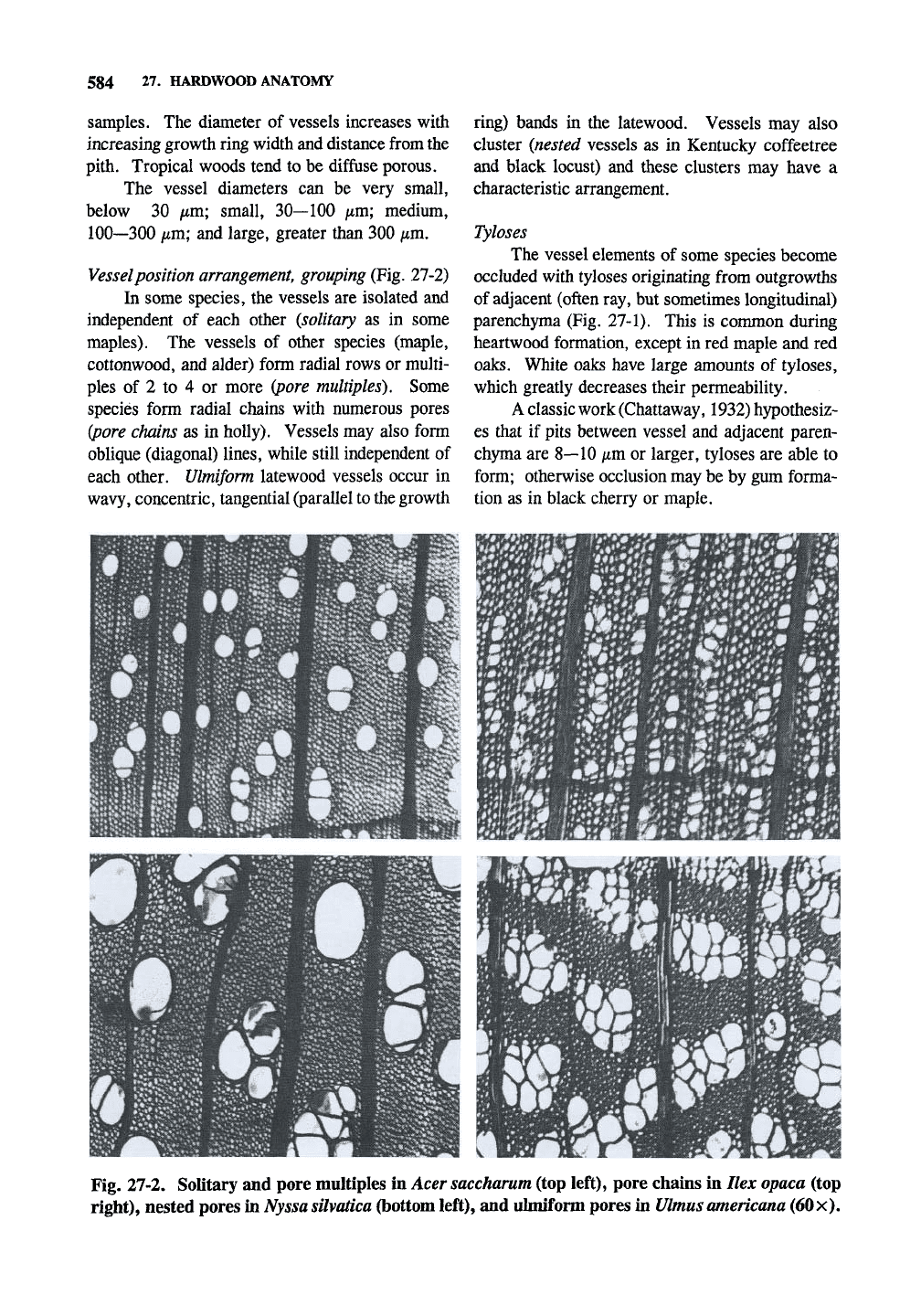
584
27.
HARDWOOD ANATOMY
samples. The diameter of vessels increases with
increasing growth ring width and distance from the
pith. Tropical woods tend to be diffuse porous.
The vessel diameters can be very small,
below 30 /xm; small, 30—100 fim; medium,
100—300 jLtm; and large, greater than 300 ^m.
Vessel position
arrangement,
grouping (Fig. 27-2)
In some species, the vessels are isolated and
independent of each other {solitary as in some
maples). The vessels of other species (maple,
Cottonwood, and alder) form radial rows or multi-
ples of 2 to 4 or more {pore multiples). Some
species form radial chains with numerous pores
{pore chains as in holly). Vessels may also form
oblique (diagonal) lines, while still independent of
each other. Ulmiform latewood vessels occur in
wavy, concentric, tangential (parallel to the growth
ring) bands in the latewood. Vessels may also
cluster {nested vessels as in Kentucky coffeetree
and black locust) and these clusters may have a
characteristic arrangement.
Tyloses
The vessel elements of some species become
occluded with tyloses originating from outgrowths
of adjacent (often ray, but sometimes longitudinal)
parenchyma (Fig. 27-1). This is common during
heartwood formation, except in red maple and red
oaks.
White oaks have large amounts of tyloses,
which greatly decreases their permeability.
A classic work (Chattaway,
1932)
hypothesiz-
es that if pits between vessel and adjacent paren-
chyma are 8—10 ^m or larger, tyloses are able to
form; otherwise occlusion may be by gum forma-
tion as in black cherry or maple.
Fig. 27-2. Solitary and pore multiples in Acer
saccharum
(top left), pore chains in Ilex opaca (top
right),
nested pores in Nyssa
silvatica
(bottom left), and ulmiform pores in
Ulmus
americana (60
x).
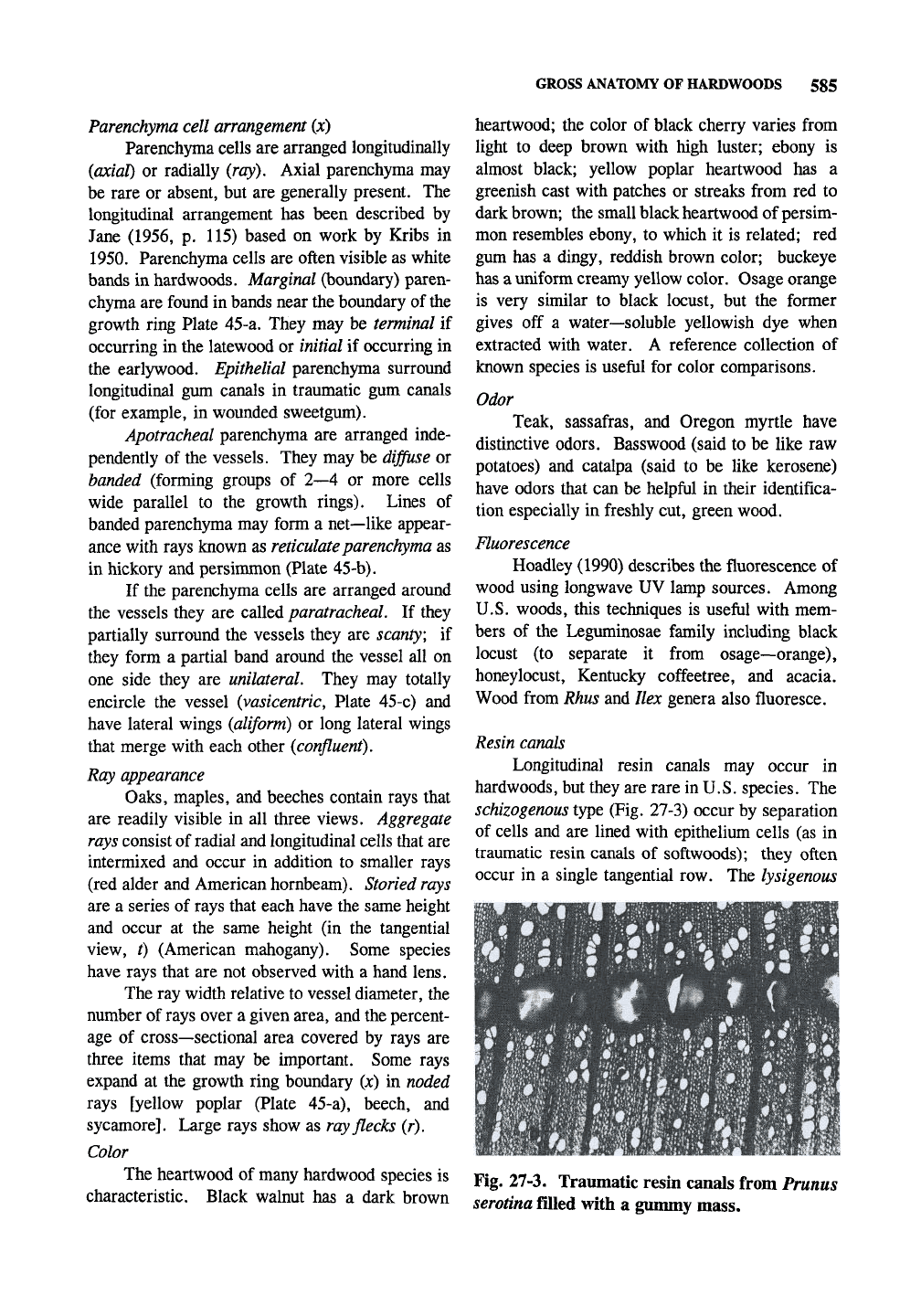
GROSS ANATOMY OF HARDWOODS 585
Parenchyma cell arrangement {x)
Parenchyma cells are arranged longitudinally
{axial) or radially {ray). Axial parenchyma may
be rare or absent, but are generally present. The
longitudinal arrangement has been described by
Jane (1956, p. 115) based on work by Kribs in
1950.
Parenchyma cells are often visible as white
bands in hardwoods. Marginal (boundary) paren-
chyma are found in bands near the boundary of the
growth ring Plate 45-a. They may be terminal if
occurring in the latewood or initial if occurring in
the earlywood. Epithelial parenchyma surround
longitudinal gum canals in traumatic gum canals
(for example, in wounded sweetgum).
Apotracheal parenchyma are arranged inde-
pendently of the vessels. They may be dijfuse or
banded (forming groups of 2—4 or more cells
wide parallel to the growth rings). Lines of
banded parenchyma may form a net—like appear-
ance with rays known as reticulate parenchyma as
in hickory and persimmon (Plate 45-b).
If the parenchyma cells are arranged around
the vessels they are called paratracheal. If they
partially surround the vessels they are scanty; if
they form a partial band around the vessel all on
one side they are unilateral. They may totally
encircle the vessel {vasicentric, Plate 45-c) and
have lateral wings (aliform) or long lateral wings
that merge with each other (confluent).
Ray appearance
Oaks,
maples, and beeches contain rays that
are readily visible in all three views. Aggregate
rays consist of radial and longitudinal cells that are
intermixed and occur in addition to smaller rays
(red alder and American hornbeam). Storied rays
are a series of rays that each have the same height
and occur at the same height (in the tangential
view, t) (American mahogany). Some species
have rays that are not observed with a hand lens.
The ray width relative to vessel diameter, the
number of rays over a given area, and the percent-
age of cross—sectional area covered by rays are
three items that may be important. Some rays
expand at the growth ring boundary (x) in noded
rays [yellow poplar (Plate 45-a), beech, and
sycamore].
Large rays show as ray flecks (r).
Color
The heartwood of many hardwood species is
characteristic. Black walnut has a dark brown
heartwood; the color of black cherry varies from
light to deep brown with high luster; ebony is
almost black; yellow poplar heartwood has a
greenish cast with patches or streaks from red to
dark brown; the small black heartwood of persim-
mon resembles ebony, to which it is related; red
gum has a dingy, reddish brown color; buckeye
has a uniform creamy yellow color. Osage orange
is very similar to black locust, but the former
gives off a water—soluble yellowish dye when
extracted with water. A reference collection of
known species is useful for color comparisons.
Odor
Teak, sassafras, and Oregon myrtle have
distinctive odors. Bass wood (said to be like raw
potatoes) and catalpa (said to be like kerosene)
have odors that can be helpful in their identifica-
tion especially in freshly cut, green wood.
Fluorescence
Hoadley (1990) describes the fluorescence of
wood using longwave UV lamp sources. Among
U.S.
woods, this techniques is useful with mem-
bers of the Leguminosae family including black
locust (to separate it from osage—orange),
honeylocust, Kentucky coffeetree, and acacia.
Wood from Rhus and Ilex genera also fluoresce.
Resin canals
Longitudinal resin canals may occur in
hardwoods, but they are rare in U.S. species. The
schizogenous
type (Fig. 27-3) occur by separation
of cells and are lined with epithelium cells (as in
traumatic resin canals of softwoods); they often
occur in a single tangential row. The lysigenous
Fig. 27-3. Traumatic resin canals from Prunus
serotina filled with a gmnmy mass.
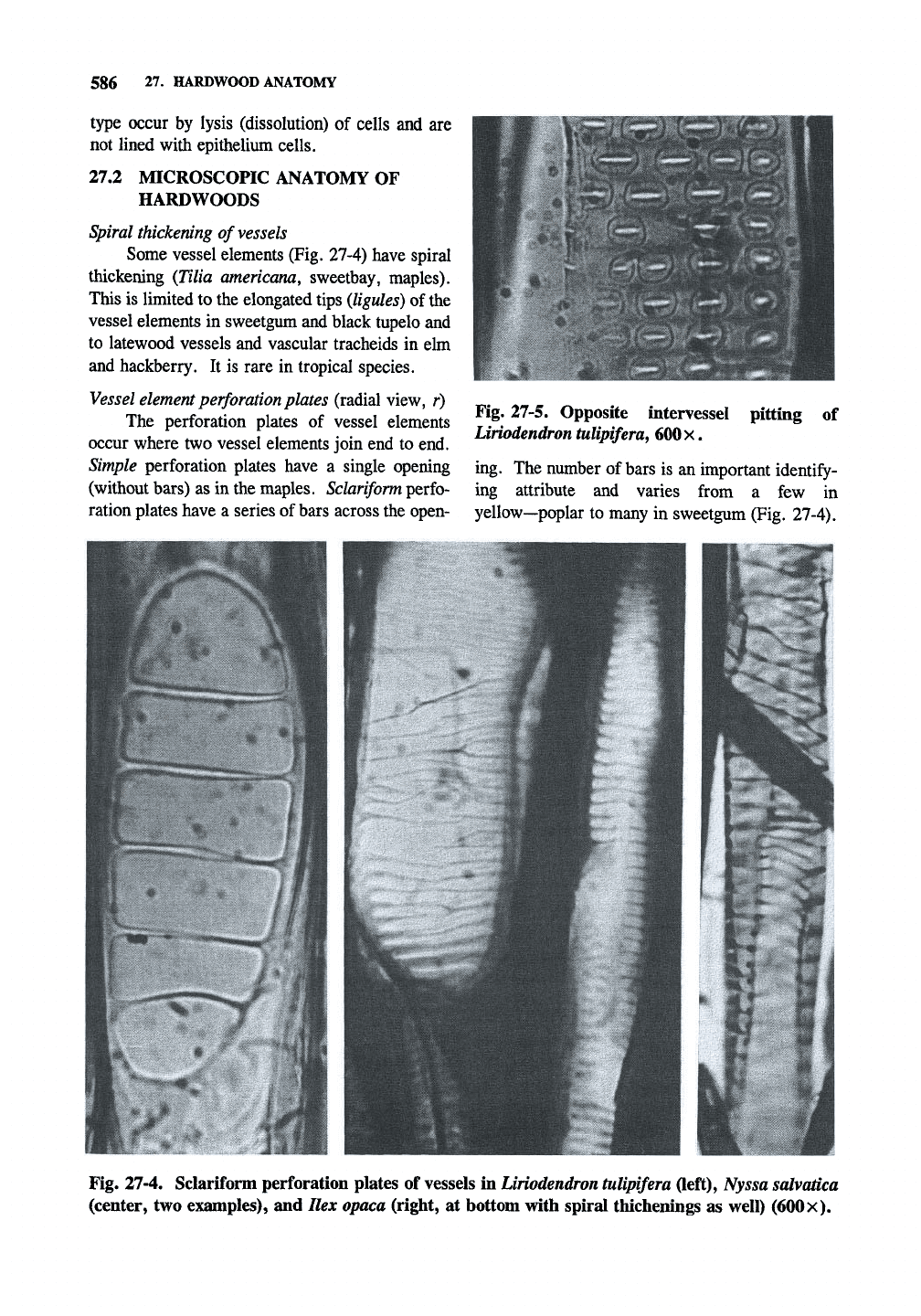
586 27. HARDWOOD ANATOMY
type occur by lysis (dissolution) of cells and are
not lined with epithelium cells.
27.2 MICROSCOPIC ANATOMY OF
HARDWOODS
Spiral thickening of
vessels
Some vessel elements (Fig. 27-4) have spiral
thickening {Tilia americana, sweetbay, maples).
This is limited to the elongated tips
(ligules)
of the
vessel elements in sweetgum and black tupelo and
to latewood vessels and vascular tracheids in ehn
and hackberry. It is rare in tropical species.
Vessel element perforation plates (radial view, r)
The perforation plates of vessel elements
occur where two vessel elements join end to end.
Simple perforation plates have a single opening
(without bars) as in the maples.
Sclariform
perfo-
ration plates have a series of
bars
across the open-
Fig. 27-5. Opposite intervessel
Liriodendron
tuHpifera,
600
x.
pitting of
ing. The number of bars is an important identify-
ing attribute and varies from a few in
yellow—poplar to many in sweetgum (Fig. 27-4).
Fig. 27-4. Sclariform perforation plates of vessels in
Liriodendron
tulipifera Oeft), Nyssa salvatica
(center, two examples), and Ilex opaca (right, at bottom with spiral thichenings as well)
(600
x).
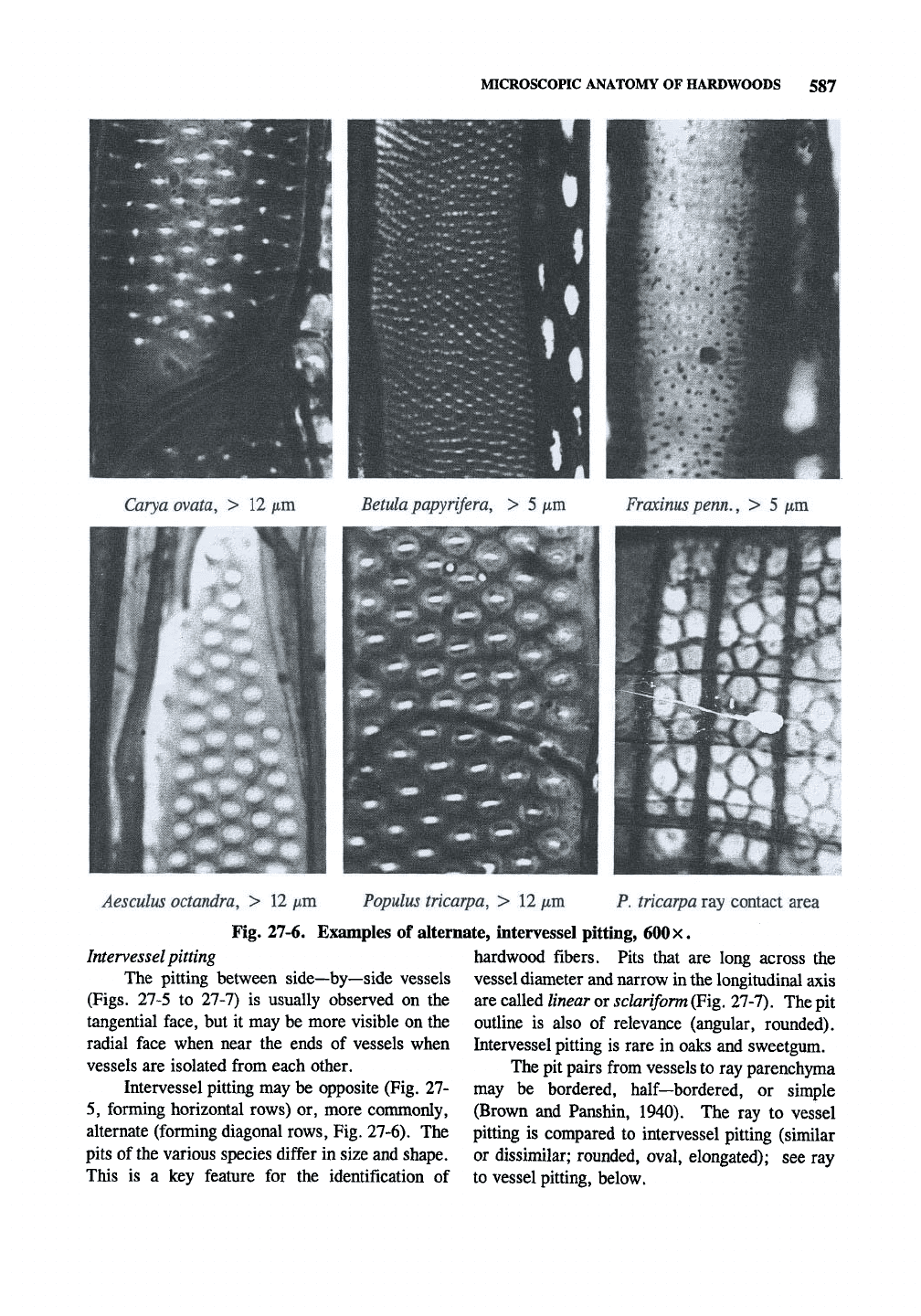
MICROSCOPIC ANATOMY OF HARDWOODS 587
Carya ovata, > 12 ptm
Betula
papyrifera, > 5 ptm
Fraxinuspenn., > 5 fim
Aesculus octandra, > 12 iim Populus tricarpa, > 12 /im P. tricarpa ray contact area
Fig. 27-6. Examples of alternate, intervessel pitting, 600 x.
Intervessel pitting
The pitting between side—by—side vessels
(Figs.
27-5 to 27-7) is usually observed on the
tangential face, but it may be more visible on the
radial face when near the ends of vessels when
vessels are isolated from each other.
Intervessel pitting may be opposite (Fig. 27-
5,
forming horizontal rows) or, more commonly,
alternate (forming diagonal rows. Fig. 27-6). The
pits of the various species differ in size and shape.
This is a key feature for the identification of
hardwood fibers. Pits that are long across the
vessel diameter and narrow in the longitudinal axis
are called linear or
sclariform
(Fig.
27-7). The pit
outline is also of relevance (angular, rounded).
Intervessel pitting is rare in oaks and sweetgum.
The pit pairs from vessels to ray parenchyma
may be bordered, half—bordered, or simple
(Brown and Panshin, 1940). The ray to vessel
pitting is compared to intervessel pitting (similar
or dissimilar; rounded, oval, elongated); see ray
to vessel pitting, below.
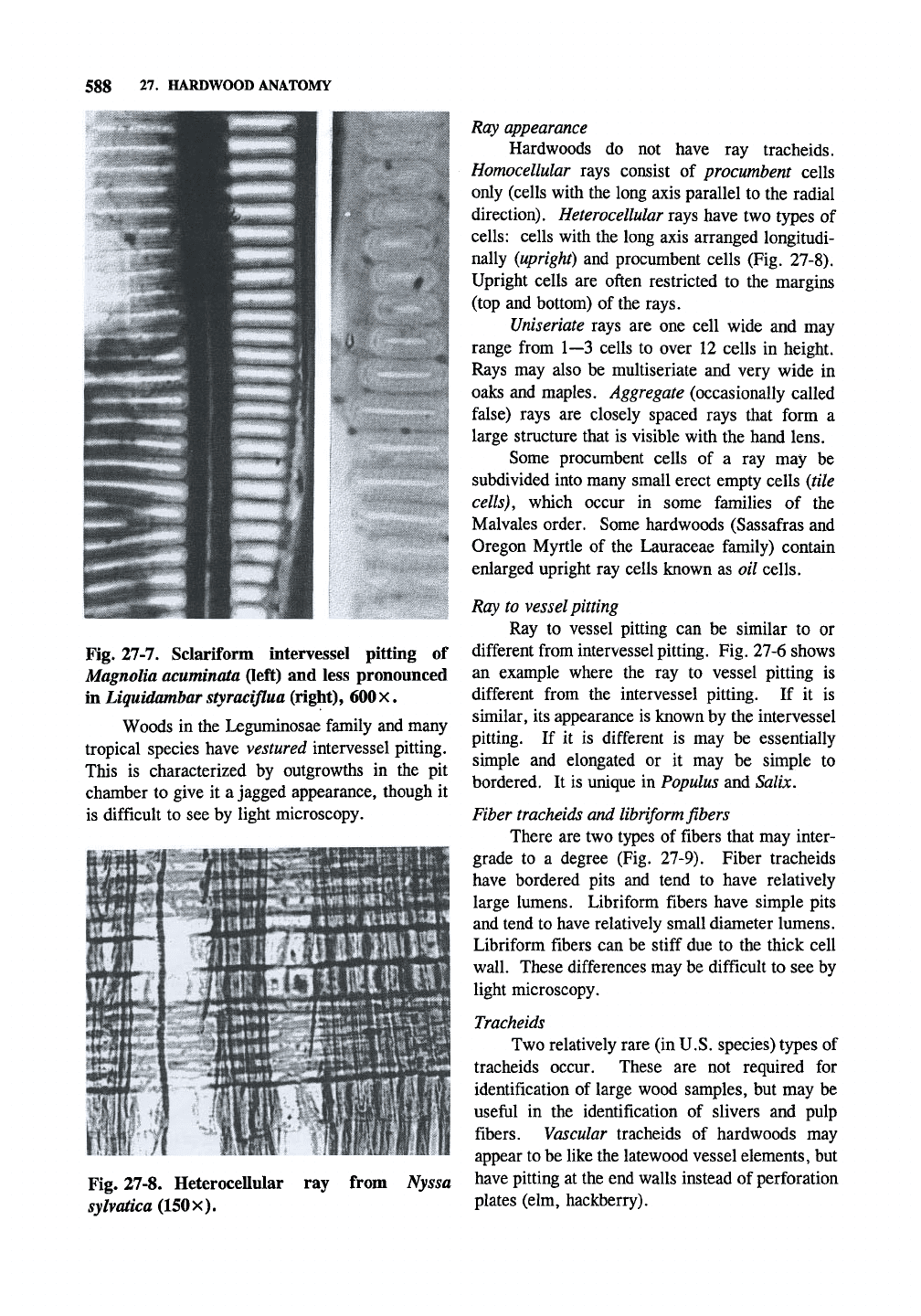
588
27.
HARDWOOD ANATOMY
Fig. 27-7. Sclariform intervessel pitting of
Magnolia acuminata (left) and less pronounced
in Liquidambar styraciflua (right), 600 x.
Woods in the Leguminosae family and many
tropical species have vestured intervessel pitting.
This is characterized by outgrowths in the pit
chamber to give it a jagged appearance, though it
is difficult to see by light microscopy.
Fig. 27-8. Heterocellular
sylvatica
(150
x).
ray from Nyssa
Ray appearance
Hardwoods do not have ray tracheids.
Homocellular rays consist of procumbent cells
only (cells with the long axis parallel to the radial
direction). Heterocellular rays have two types of
cells:
cells with the long axis arranged longitudi-
nally {upright) and procumbent cells (Fig. 27-8).
Upright cells are often restricted to the margins
(top and bottom) of the rays.
Uniseriate rays are one cell wide and may
range from 1—3 cells to over 12 cells in height.
Rays may also be multiseriate and very wide in
oaks and maples. Aggregate (occasionally called
false) rays are closely spaced rays that form a
large structure that is visible with the hand lens.
Some procumbent cells of a ray may be
subdivided into many small erect empty cells (tile
cells),
which occur in some families of the
Malvales order. Some hardwoods (Sassafras and
Oregon Myrtle of the Lauraceae family) contain
enlarged upright ray cells known as oil cells.
Ray to vessel pitting
Ray to vessel pitting can be similar to or
different from intervessel pitting. Fig. 27-6 shows
an example where the ray to vessel pitting is
different from the intervessel pitting. If it is
similar, its appearance is known by the intervessel
pitting. If it is different is may be essentially
simple and elongated or it may be simple to
bordered. It is unique in Populus and Salix.
Fiber
tracheids
and libriform fibers
There are two types of fibers that may inter-
grade to a degree (Fig. 27-9). Fiber tracheids
have bordered pits and tend to have relatively
large lumens. Libriform fibers have simple pits
and tend to have relatively small diameter lumens.
Libriform fibers can be stiff due to the thick cell
wall. These differences may be difficult to see by
light microscopy.
Tracheids
Two relatively rare (in
U.S.
species) types of
tracheids occur. These are not required for
identification of large wood samples, but may be
useful in the identification of slivers and pulp
fibers.
Vascular tracheids of hardwoods may
appear to be like the latewood vessel elements, but
have pitting at the end walls instead of perforation
plates (elm, hackberry).
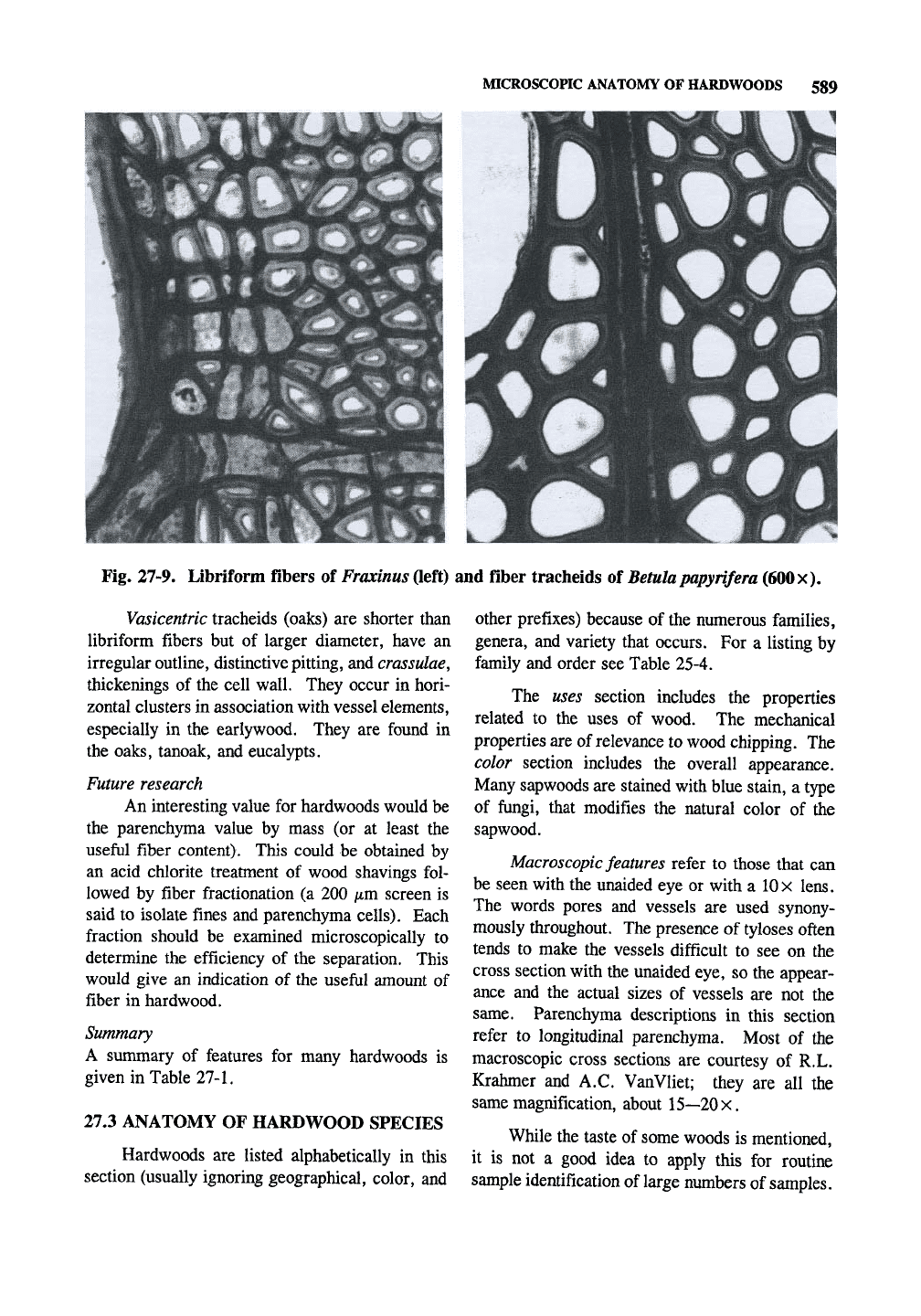
MICROSCOPIC ANATOMY OF HARDWOODS
589
1
r
^1^$
Fig. 27-9. Libriform fibers of
Fraxinus
(left) and fiber tracheids of
Betula
papyrifera
(600
x).
Vasicentric tracheids (oaks) are shorter than
libriform fibers but of larger diameter, have an
irregular outline, distinctive pitting, and crassulae,
thickenings of the cell wall. They occur in hori-
zontal clusters in association with vessel elements,
especially in the earlywood. They are found in
the oaks, tanoak, and eucalypts.
Future research
An interesting value for hardwoods would be
the parenchyma value by mass (or at least the
useful fiber content). This could be obtained by
an acid chlorite treatment of wood shavings fol-
lowed by fiber fractionation (a 200 jum screen is
said to isolate fines and parenchyma cells). Each
fraction should be examined microscopically to
determine the efficiency of the separation. This
would give an indication of the useful amount of
fiber in hardwood.
Summary
A sunmiary of features for many hardwoods is
given in Table 27-1.
27.3 ANATOMY OF HARDWOOD SPECIES
Hardwoods are listed alphabetically in this
section (usually ignoring geographical, color, and
other prefixes) because of the numerous families,
genera, and variety that occurs. For a listing by
family and order see Table 25-4.
The uses section includes the properties
related to the uses of wood. The mechanical
properties are of relevance to wood chipping. The
color section includes the overall appearance.
Many sapwoods are stained with blue stain, a type
of fungi, that modifies the natural color of the
sapwood.
Macroscopic features refer to those that can
be seen with the unaided eye or with a lOx lens.
The words pores and vessels are used synony-
mously throughout. The presence of tyloses often
tends to make the vessels difficult to see on the
cross section with the unaided eye, so the appear-
ance and the actual sizes of vessels are not the
same. Parenchyma descriptions in this section
refer to longitudinal parenchyma. Most of the
macroscopic cross sections are courtesy of R.L.
Krahmer and A.C. VanVliet; they are all the
same magnification, about 15—20x.
While the taste of some woods is mentioned,
it is not a good idea to apply this for routine
sample identificafion of large numbers of samples.

590
27.
HARDWOOD ANATOMY
Table 27-1. Anatomical characteristics of deciduous woods useful in their identification.
0^0^0^0^0^0^0^000
§:.§
i I
•S
^
II
II
3 Q
OQ ^ S
S "^
«n
m
»r> ir> vo oo o>
o o o o o o o
so vo vo vo vo vo vo
3
•a D
;5
I
S3
<^
c3<i;c3:|
<3S
I
II
=55 O
I
Is
•S
?
.Bb
^
S
S
I I
ft- ^
O
i
O
o
U
< < <
ti -^ *^ ^
o
S3
0) U U ^
ij '^ s: o o g
I ^ ^
?^
^ ^
< 1
2 3 «
< ^ e
- >% o
SCO,
' o o
X X
2i
o
a
Use this for alignment
Vessels
Ring porous
Semi-ring porous
Diffuse porous
Spiral thickening
Arrangement-mostly solitary
-of clusters
Perforation plates-simple
1234567890123456789012345678
XX X X XXXXxXX X
XXX XX
XXXXX XX XXXXX
L A
L L L L
F L A A L F
-SSX SX SS
-MMMMMMMNMMMMWWWWMMCNMMNM M
XXX XXXXXX XXXXXX XXXX
-scalariform (T some >10 bars) - T S S T
S S T
S
S
Intervessel pitting
Opposite
Alternate
Scalariform
Linear
Fibers
Libriform
Fiber tracheids
Ray composition
heterocellular
homocellular
Ray-vessel pitting (1, 2, 3)
Tracheids present
Use this for alignment
- S X
-xxxxxxxxxxx xxxxxxxxxxxx
X
X
X X X X XXXXXX XX X
-X XXXSX XXXX XXX X X
? ?SSS XX XXXX SXSX
xxxxxxxxxxxx XXX XX X
X
X
X
X
X
X
311 31211 331333211113333 3
C C R R R R
1234567890123456789012345678
Key: X indicates characteristic is pronounced, x indicates characteristic is present but not pronounced (when used
with X, it is the less likely of
the
two choices). S indicates a feature is sporadic, ? indicates sources disagree. Spiral
thickening [Core et al, 1979, P. 78] S) sporadic. A) all vessels, L) latewood vessels only, F) fibers and vessels, T)
vessel tips only. Vessel arrangement of clusters M) multiples, C) chains, W) wavy bands, N) nested. Ray vessel
pitting [Core et al, 1979, P. 68] 1) essentially like intervessel pitting, 2) essentially simple, 3) simple to bordered.
Tracheids present C) vascicentric, R) vascular. Source: Panshin and de Zeeuw (1980); Hoadley (1990); and others.
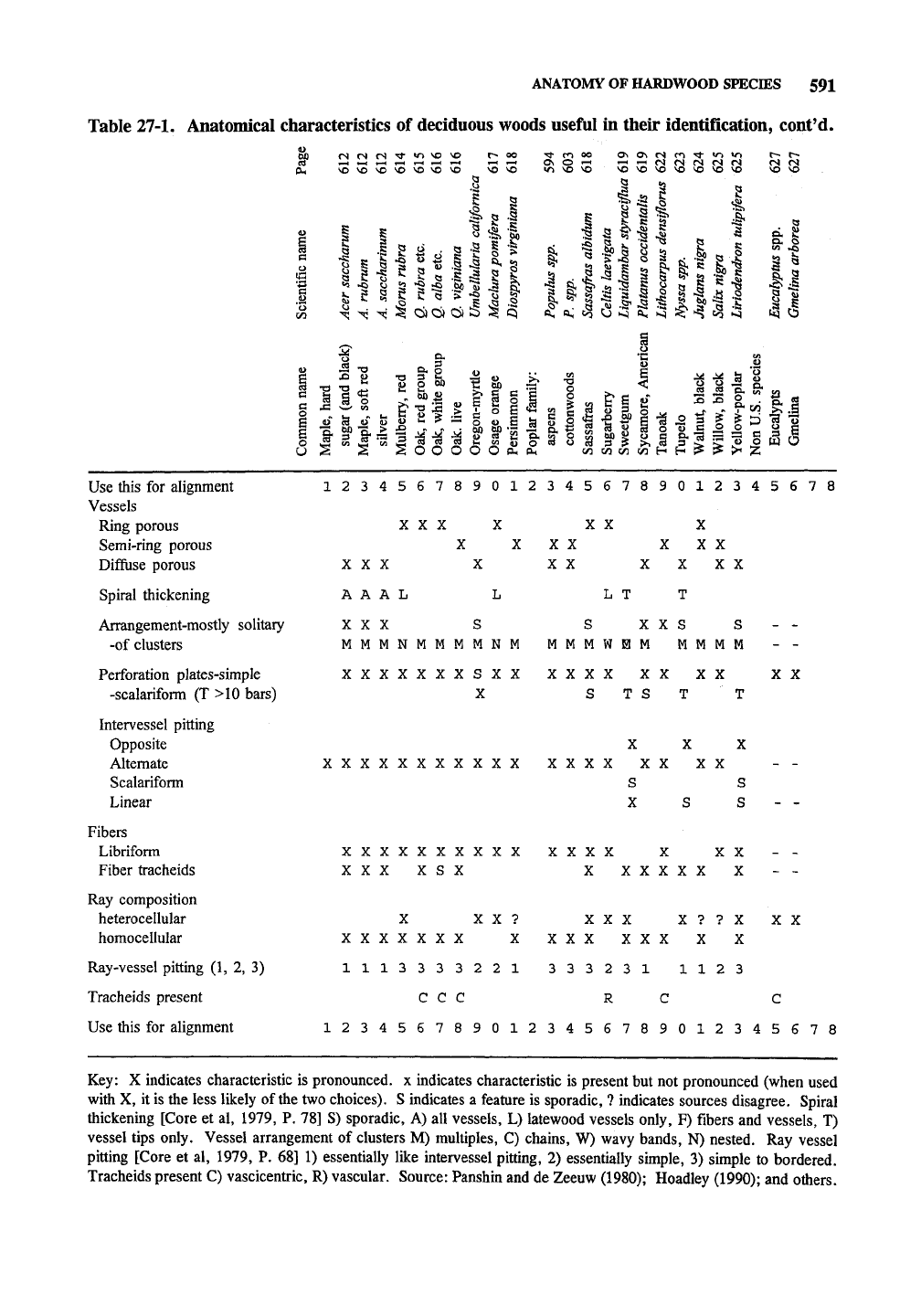
ANATOMY
OF HARDWOOD
SPECIES 591
Table 27-1. Anatomical characteristics of deciduous woods useful in their identification, cont'd.
LI
.III i ,
9.§
o
2
I
:-i:-
6IIIII
° 11
i
111 !>
I
i^
o ^
I rs f I
i|f|l|§ll||llllilill||il|l^
Use this for alignment 1234567890123456789012345678
Vessels
Ring porous XXX X XX X
Semi-ring porous X XXX XXX
Diffiise porous XXX X XX XXXX
Spiral thickening AAAL L LT T
Arrangement-mostly solitary XXX S S XXS S--
-of clusters MMMNMMMMNM MMMWHM MMMM --
Perforation plates-simple XXXXXXXSXX XXXX XX XX XX
-scalariform (T >10 bars) X S T S T T
Intervessel pitting
Opposite XXX
Alternate XXXXXXXXXXX XXXX XX XX --
Scalariform S S
Linear X S S - -
Fibers
Libriform XXXXXXXXXX XXXX X XX --
Fiber tracheids XXX XSX X XXXXX X --
Ray composition
heterocellular X XX? XXX X??XXX
homocellular XXXXXXX X XXX XXX X X
Ray-vessel pitting (1, 2, 3) 1113333221 333231 1123
Tracheids present C C C R C C
Use this for alignment 1234567890123456789012345678
Key: X indicates characteristic is pronounced, x indicates characteristic is present but not pronounced (when used
with X, it is the less likely of the two choices). S indicates a feature is sporadic, ? indicates sources disagree. Spiral
thickening [Core et al, 1979, P. 78] S) sporadic. A) all vessels, L) latewood vessels only, F) fibers and vessels, T)
vessel tips only. Vessel arrangement of clusters M) multiples, C) chains, W) wavy bands, N) nested. Ray vessel
pitting [Core et al, 1979, P. 68] 1) essentially like intervessel pitting, 2) essentially simple, 3) simple to bordered.
Tracheids present C) vascicentric, R) vascular. Source: Panshin and de Zeeuw (1980); Hoadley (1990); and others.
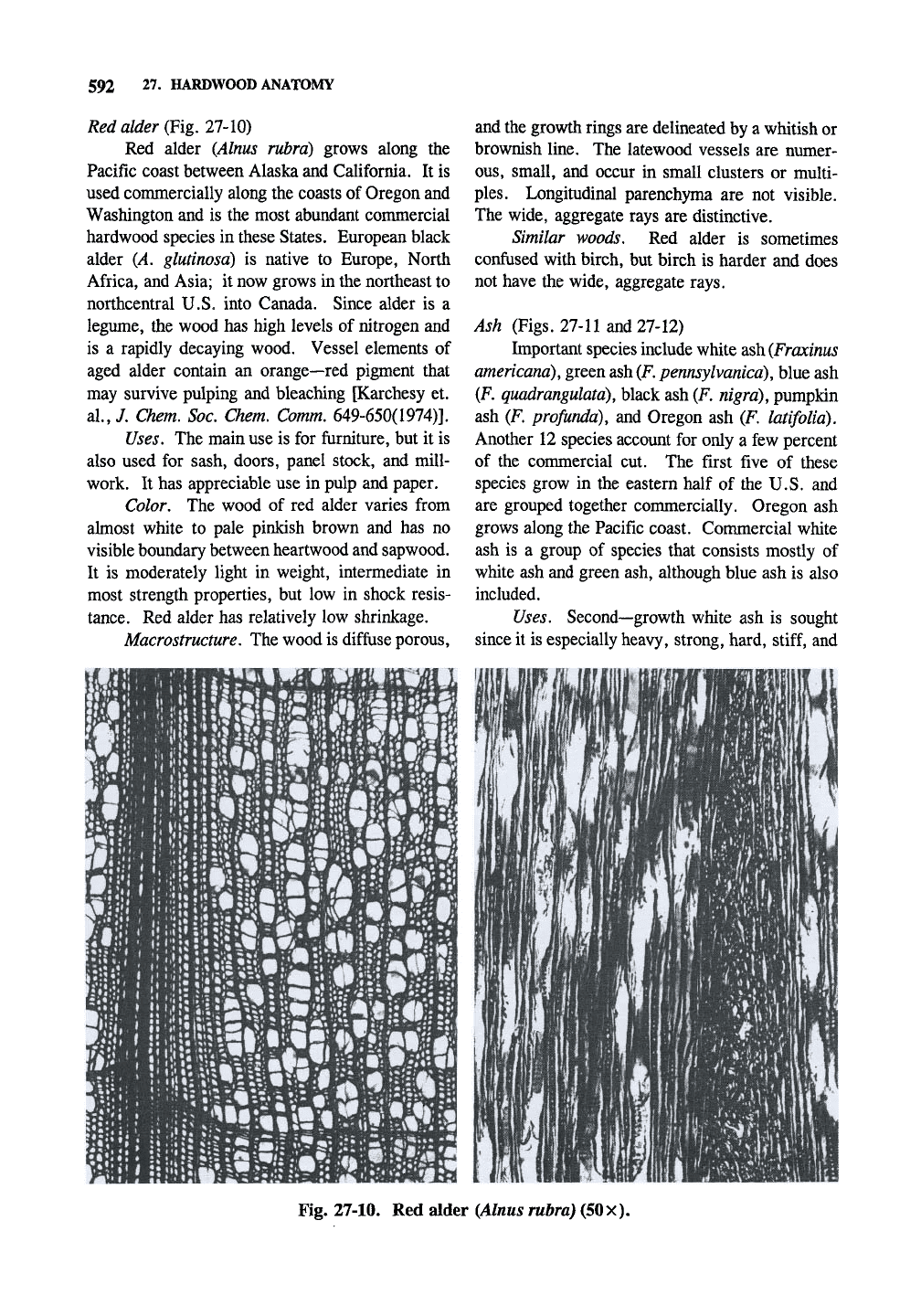
592 27. HARDWOOD ANATOMY
Red alder (Fig. 27-10)
Red alder (Alnus rubra) grows along the
Pacific coast between Alaska and California. It is
used commercially along the coasts of Oregon and
Washington and is the most abundant commercial
hardwood species in these States. European black
alder (A. glutinosa) is native to Europe, North
Africa, and Asia; it now grows in the northeast to
northcentral U.S. into Canada. Since alder is a
legume, the wood has high levels of nitrogen and
is a rapidly decaying wood. Vessel elements of
aged alder contain an orange—red pigment that
may survive pulping and bleaching [Karchesy et.
al.,
7. Chem. Soc. Chem. Comm. 649-650(1974)].
Uses, The main use is for furniture, but it is
also used for sash, doors, panel stock, and mill-
work. It has appreciable use in pulp and paper.
Color, The wood of red alder varies from
almost white to pale pinkish brown and has no
visible boundary between heartwood and sapwood.
It is moderately light in weight, intermediate in
most strength properties, but low in shock resis-
tance. Red alder has relatively low shrinkage.
Macrostructure, The wood is diffuse porous.
and the growth rings are delineated by a whitish or
brownish line. The latewood vessels are numer-
ous,
small, and occur in small clusters or multi-
ples.
Longitudinal parenchyma are not visible.
The wide, aggregate rays are distinctive.
Similar woods. Red alder is sometimes
confused with birch, but birch is harder and does
not have the wide, aggregate rays.
Ash (Figs. 27-11 and 27-12)
Important species include white ash
(Fraxinus
americana), green ash
(F.
pemsylvanica), blue ash
(F.
quadrangulata),
black ash
(F.
nigra), pumpkin
ash (F. profunda), and Oregon ash (F. latifolia).
Another 12 species account for only a few percent
of the commercial cut. The first five of these
species grow in the eastern half of the U.S. and
are grouped together commercially. Oregon ash
grows along the Pacific coast. Commercial white
ash is a group of species that consists mostly of
white ash and green ash, although blue ash is also
included.
Uses. Second—growth white ash is sought
since it is especially heavy, strong, hard,
stiff,
and
Fig. 27-10. Red alder
{Alnus
rubra) (50x).
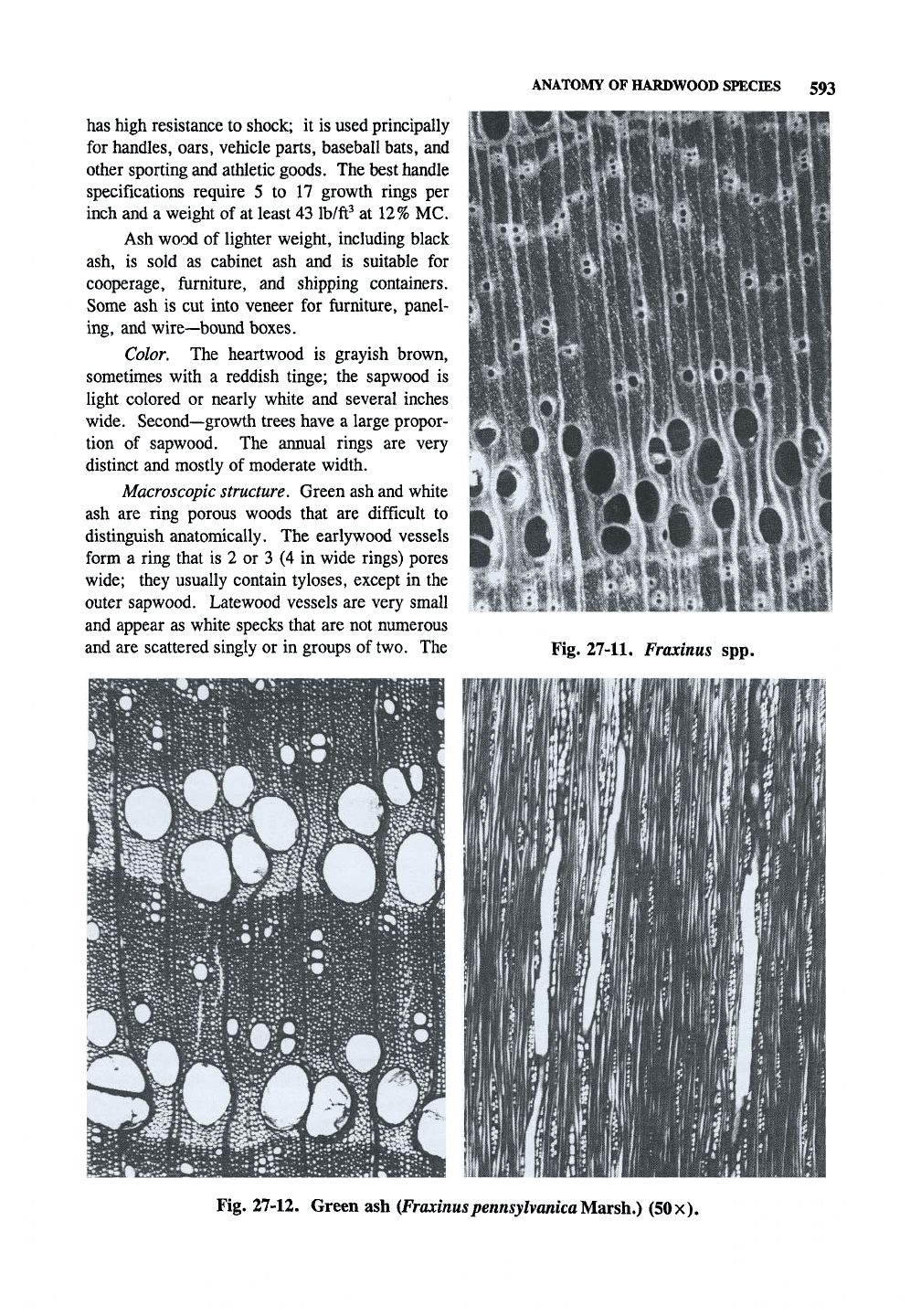
ANATOMY OF HARDWOOD SPECffiS 593
has high resistance to shock; it is used principally
for handles, oars, vehicle parts, baseball bats, and
other sporting and athletic goods. The best handle
specifications require 5 to 17 growth rings per
inch and a weight of at least 43 Ib/ft^ at 12% MC.
Ash wood of lighter weight, including black
ash, is sold as cabinet ash and is suitable for
cooperage, furniture, and shipping containers.
Some ash is cut into veneer for furniture, panel-
ing, and wire—bound boxes.
Color. The heartwood is grayish brown,
sometimes with a reddish tinge; the sapwood is
light colored or nearly white and several inches
wide. Second—growth trees have a large propor-
tion of sapwood. The annual rings are very
distinct and mostly of moderate width.
Macroscopic structure. Green ash and white
ash are ring porous woods that are difficult to
distinguish anatomically. The early wood vessels
form a ring that is 2 or 3 (4 in wide rings) pores
wide; they usually contain tyloses, except in the
outer sapwood. Latewood vessels are very small
and appear as white specks that are not numerous
and are scattered singly or in groups of
two.
The
• ilni I-n
^
i
Fig.
27-11.
Fraxinus spp.
Fig. 27-12. Green ash
(FraxinuspennsylvanicaMsLrsh.)
(50x).
